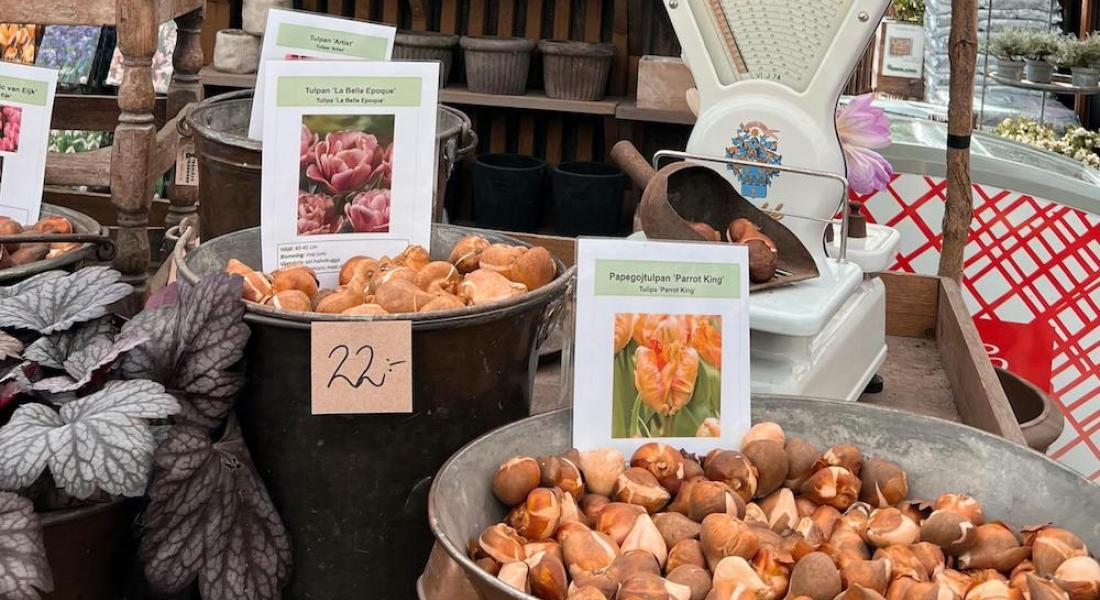Perhaps autumn signals the end of the gardening season, but to us avid gardeners, this is just the start of something brilliant. During this period, the best thing to do is to set up a sensational and colorful spring garden by planting bulbs. Those little bundles of energy we tuck into the earth now will reward us with some of the most stunning blooms once the temperature goes up. Whether planting tulips, daffodils, or crocuses, we will guide you through it so your garden may explode next spring.
Within our guide, we take you through all you need to know - from selecting the best bulbs through planting and their aftercare - to guarantee that you have something wonderful to look at come spring.
In this article:
- Why Plant Bulbs in Autumn?
- Choosing the Right Bulbs
- Preparing the Soil
- How to Plant Bulbs
- Bulb Care After Planting
- Common Mistakes to Avoid
- Extra Tips for Success
- What to Expect in Spring
Why Plant Bulbs in Autumn?
There's a good reason fall is the prime season for bulb planting. Bulbs need time to establish strong roots before winter sets in, and a period of cold temperatures is generally a requirement for inducing the rest period that leads to spring flowering. Fall planting allows bulbs many months to settle in, gather reserves of energy, and get ready for their big entrance when the days begin to lengthen.
Another advantage is you will be ahead of the game! At the beginning of spring, when most plants are still sleeping, bulbs like tulips and daffodils, and even crocuses, will already be itching to strut their stuff and bring the magic of early color into your garden.
Choosing the Right Bulbs
The key to a successful spring garden starts with selecting the right bulbs. Not all bulbs are created equal, and selecting the best varieties for autumn planting will help you achieve the most stunning results in spring. Some of our top recommendations include:
1. Tulips
Tulips are the classic spring flower, known for their vibrant colors and elegant shape. Hundreds of varieties are available, from the tall and stately Darwin hybrids to the delicate fringed tulips.
Best varieties for spring:
- Apricot Beauty: This soft apricot-colored tulip is truly beautiful and one of the earliest to bloom.
- Queen of Night: deep, almost black petals that bring drama to any garden.
- Angelique: double-flowered variety with romantic, peony-like blooms in soft pink.
2. Daffodils (Narcissus)
Such bulbs are among the most dependable, repeatedly coming year after year to brighten up any yard with trumpet-shaped flowers in shades of yellow, white, and even pink.
Best spring varieties:
- Tête-à-Tête: A dwarf type, perfect for borders and pots.
- Ice Follies: Large white flowers with a pale yellow center for a soft, natural look.
- Pink Charm: Unusual daffodil in creamy petals with a soft pink trumpet.
3. Crocuses
The crocuses are some of the first flowers to bloom during spring, often even pushing their way up through remaining snow. Their little, cuplike flowers come in a variety of colors and splash early spring gardens with color.
Best varieties for spring:
- Ruby Giant: Deep purple flowers striking a bold contrast against the late-winter landscape.
- Cream Beauty: Trunk, cream-colored flowers, which can serve for mass planting.
- Pickwick: A variety bearing striking, purple-striped flowers that would stand in rock gardens.
4. Hyacinths
Hyacinths are famous for their densely flowered spikes with intensely scented flowers in every color of the rainbow. These flowers provide fragrance and color to the spring garden.
Best varieties for spring:
- Blue Jacket: A deep blue, classical hyacinth that brings a rich pop of color to the spring.
- Woodstock: Offering something a little bit different, flowers of 'Woodstock' are dark magenta-purple.
- Pink Pearl: Soft pink in bloom, 'Pink Pearl' is ideal for adding a touch of femininity across your spring garden.
5. Alliums
These allium members produce vibrant, globe-shaped flower heads on tall stems. Alliums are one-of-a-kind and form a modern, architectural look in your garden.
Best varieties for spring:
- Purple Sensation: Vibrant purple globes that should be part of every bold spring garden
- Globemaster: Huge, rounded flower heads to as much as 10 inches across.
- Mount Everest: Elegant white alliums that offer a wonderful neutral backdrop to bright-colored flowers.
Now that you know what bulbs to choose, let's dive into how to prepare your garden to give them the best possible start.
Preparing the Soil
Healthy soil is the starting block of any successful garden. Before we go about digging holes for our bulbs, it is important to prepare the soil in advance.
Location Selection
First comes the right location. Most spring-flowering bulbs prefer full sun; that is, at least six hours of direct sunlight in your garden every day. The bulbs of crocuses and snowdrops do not have this restriction and can grow even in partial shade; therefore, they are very suitable under trees or shrubs.
Soil Preparation
The land preparation will be the next step. Bulbs like well-draining soils because sitting in waterlogged earth will make them rot. If your soil is heavy or more clay-like, you can soften it by mixing in organic matter such as compost or leaf mold. This improves drainage and provides vital nourishment for the bulbs.
You'll also want to check the pH level of your soil. Most bulbs prefer slightly acidic to neutral soil-a pH of 6 to 7. You can easily adjust the pH with lime-to raise it-or sulfur-to lower it-dependent upon your needs.
How to Plant Bulbs
Planting bulbs is easy and rewarding, but the real payoff occurs in the spring. Here is a general guide to ensure success:
General Planting Guidelines
1. Timing: The plantations of the bulbs should be done about 6-8 weeks in advance before the freeze-up. This is usually between late September and November, depending on your location.
2. Depth and Spacing: A rough estimate can be made that for every bulb, the depth should be roughly 2-3 times its height. So if your tulip bulb happens to be 2 inches tall, you need to plant it in about 4-6 inches of depth. Spacing depends on the size of the bulb: larger ones will need roughly 4-6 inches between them, while smaller bulbs, such as crocuses, can be situated closer to one another, about 2-3 inches apart.
Step-by-Step Planting Guide
1. Dig the hole: Using a trowel or bulb planter, scoop out enough deep for bulb space. Planting a large group; you can do this more quickly by digging trenches.
2. Add fertilizer: Place a small amount of bulb fertilizer or bone meal in the bottom of the hole. These extra nutrients will provide an added boost to your bulbs as they start to form their roots.
3. Place the bulb: Position the bulb, pointed end up. This is very important, as the shoots must push up through the soil when spring arrives.
4. Backfill the hole: Fill in the soil around the bulb and settle it in, gently tamping out air pockets with your hands.
5. Water in thoroughly: Immediately water your bulbs well to settle them in place.
Bulb Care After Planting
Once your bulbs are planted, there is little to do until spring, but a bit of care now will pay off then.
Watering Needs
After planting, water your bulbs well to start root development. Once the ground freezes, you will no longer need to water because the bulb will go into dormancy and have no moisture need during winter months.
Mulching
One of the best ways to protect your bulbs over winter is mulching. A 2-3 inch layer of organic mulch, such as shredded leaves or straw, insulates the soil and keeps moisture in while preventing bulbs from freezing during extreme cold snaps.
Protection from Pests
One of the single largest threats to the well-being of bulbs are hungry wildlife, especially squirrels and deer. You can prevent digging by laying down wire mesh over the planting area or sprinkle a natural repellent, such as cayenne pepper or blood meal, around the garden.
Common Mistakes to Avoid
Even experienced gardeners make mistakes sometimes. The following are a couple of common mistakes people make when planting the bulbs, which one needs to avoid:
Planting Bulbs Too Early or Too Late
Timing is everything. If you plant too early, the bulbs might start sprouting before winter sets in. Sometimes sprouting too early weakens and even kills the bulb. Conversely, if you plant too late, they may not have enough time to take root before the ground freezes over. Aim for mid-to-late autumn for the best results.
Planting Bulbs Upside Down
It is amazingly easy to plant bulbs upside down. Always make sure the pointed end goes upwards as that is where the shoot will appear.
Overwatering
While bulbs need moisture to establish a root system, too much water can cause them to rot. After the initial watering, allow the soil to dry out a little before you water again especially if you are in a rainy climate.
Extra Tips for Success
Layering Bulbs for Extended Blooms
One of the coolest tricks in long floral display is planting bulbs in layers, as known as the "lasagna method." You can set up continuous blooms throughout the season by layering a mix of bulbs that will bloom early, mid and late spring in the same hole or container.
Planting Bulbs in Containers
If space is limited, or you would like to bring some of the spring beauty closer to your home, planting bulbs in containers is a fine thing to do-just make sure you put them in a pot with good drainage and layer bulbs like you would in the ground.
What to Expect in Spring
Watch for early signs of life once the weather starts to warm up. Bulbs will begin sending up shoots, sometimes as early as late winter depending on your climate. When this happens, it will be very important to continue watering as needed but also add a little fertilizer to keep growth strong.
Before you know it, your garden will be a riot of color, and you will be enjoying the fruits of your fall planting labor.
Conclusion
Planting bulbs in autumn is perhaps one of the most rewarding things one may ever undertake as a gardener. With just a little bit of preparation and attention to care, you will be rewarded with a beautiful display of tulips, daffodils, crocuses, and many more when spring comes. So grab your gardening tool, pick up some of those gorgeous bulbs, and let's get planting. We can't wait to see what you will create!



